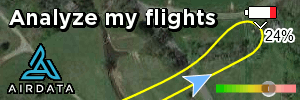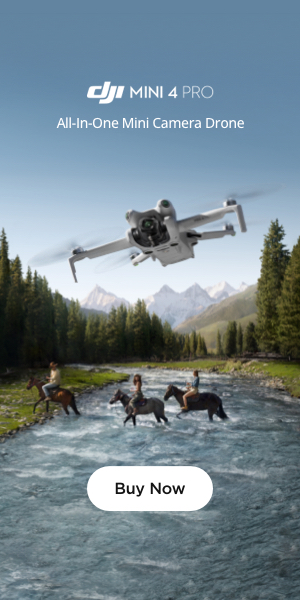The person wanting my photos wanted me to take them in RAW format but I don't have that setting on the Mini so what setting is a good one for the best quality that a professional can use to edit with?
You are using an out of date browser. It may not display this or other websites correctly.
You should upgrade or use an alternative browser.
You should upgrade or use an alternative browser.
Photo settings
- Thread starter Sara S
- Start date
Hi Sara, your going to be pretty limited with the mini as it only shoots jpeg. You will need a bigger and better drone if you want to shoot in raw.
You can still get some really nice photos with the mini and do some reasonable editing but jpegs are only going to get you so far.
If you are working in tricky lighting, in particular sun rises and sunsets you can manually do exposure bracketing which for starters would be, 1 over exposed photo, 1 correctly exposed photo and 1 under exposed photo which you would then merge together to create a single HDR image.
A google search of“ manual exposure bracketing “ should get you a bunch of Youtube tutorials.
Hope this helps.
You can still get some really nice photos with the mini and do some reasonable editing but jpegs are only going to get you so far.
If you are working in tricky lighting, in particular sun rises and sunsets you can manually do exposure bracketing which for starters would be, 1 over exposed photo, 1 correctly exposed photo and 1 under exposed photo which you would then merge together to create a single HDR image.
A google search of“ manual exposure bracketing “ should get you a bunch of Youtube tutorials.
Hope this helps.
Chanctonbury
Well-Known Member
Before I do any editing of my Mavic Images, I save them them as either TIF or PNG files so that the quality doesn't degrade further - this will give you the best quality even after you have manipulated the images in an image processing package.
WithTheBirds
Well-Known Member
- Joined
- Sep 2, 2018
- Messages
- 2,560
- Reactions
- 1,601
Is this suggested workflow for the Mavic Mini?Before I do any editing of my Mavic Images, I save them them as either TIF or PNG files so that the quality doesn't degrade further - this will give you the best quality even after you have manipulated the images in an image processing package.
The best known means to ensure non destructive edits is to shoot, keep, and work directly from, RAW files.
It is hard to imagine what advantage might be realised from converting a RAW or JPG file to a TIFF or PNG. Actually a PNG is probably a poor choice for image storing and processing. In many cases a RAW converted to PNG results in a larger file with no chance of maintaining the flexibility and options available working directly with the original RAW file.
D
Deleted member 114292
Guest
I’ve hung out on a lot of photography forums and I never heard anything about saving a jpeg as a PNG preserving image quality.Before I do any editing of my Mavic Images, I save them them as either TIF or PNG files so that the quality doesn't degrade further - this will give you the best quality even after you have manipulated the images in an image processing package.
Maybe you’re onto something but I’d be interesting to see some evidence that that’s correct.
JPEG editing is just as non-destructive as in any other format as long as you don’t save it back to the same file.
It’s the editor that makes it non-destructive not the file format.
It’s also a myth that saving JPEG‘s multiple times degrades the quality. Google it up and you’ll find experiments have been done saving a JPEG hundreds of times with quality degradation so small you had to use a tool to notice it.
Of course in the normal course of editing you never save it back to the same file so it’s a moot point.
if you use Lightroom or a similar program you won’t be saving it back to the same JPEG file you’ll export your edited version.
While raw format It is preferred there’s no reason a JPEG that’s within a stop or two of correct exposure can’t be edited effectively.
Last edited by a moderator:
Dave Maine
Well-Known Member
- Joined
- Jan 27, 2018
- Messages
- 1,546
- Reactions
- 1,123
- Age
- 82
PNG or tiff will maintain whatever quality the initial image has. It will not improve the initial poor image, but will make further editing less likely to degrade the image additionally. Editing jpg images in Photoshop and others like it resave the image in its initial format, adding another lossy generation.
Lightroom and others that handle image fixes with a series of stored commands do not do this, although when they export they do add another generation, and some loss at that point.
Most all serious photographers will not use jpg images at all as a starting point. They are just too limited.
Lightroom and others that handle image fixes with a series of stored commands do not do this, although when they export they do add another generation, and some loss at that point.
Most all serious photographers will not use jpg images at all as a starting point. They are just too limited.
Happyonmyhill
Active Member
I’ve hung out on a lot of photography forums and I never heard anything about saving a jpeg as a PNG preserving image quality.
Maybe you’re onto something but I’d be interesting to see some evidence that that’s correct.
JPEG editing is just as non-destructive as in any other format as long as you don’t save it back to the same file.
It’s the editor that makes it non-destructive not the file format.
It’s also a myth that saving JPEG‘s multiple times degrades the quality. Google it up and you’ll find experiments have been done saving a JPEG hundreds of times with quality degradation so small you had to use a tool to notice it.
Of course in the normal course of editing you never save it back to the same file so it’s a moot point.
if you use Lightroom or a similar program you won’t be saving it back to the same JPEG file you’ll export your edited version.
While raw format It is preferred there’s no reason a JPEG that’s within a stop or two of correct exposure can’t be edited effectively.
Happyonmyhill
Active Member
Agree completely. If you need to shoot RAW step up to a drone camera that supports it. I would say for 95% of us out there the mini’s JPEG rendering is totally acceptable and editable. They don’t degrade. I’m super happy with my mini’s camera and I own a Sony AIII with a lot of very expensive glass. RAW is helpful in fine tuning exposure in difficult lighting because it is uncompressed. All the sensor data is available. JPEG uses devices software to eliminate some data while keeping what’s needed making for much smaller file sizes. I’d rather plan my shots carefully and try to get exposure correct out of camera. As stated, upgrade to Pro2 if you want RAW capability but for most JPEG is just fine. It’s sorta like a really good sound system vs one that costs 10x as much but requires an incredibly sensitive ear to hear the difference!
D
Deleted member 114292
Guest
Professional photographers use JPEG’s all the time for example if you’re a sports photographer you’ll shoot JPEG because you have to submit it right away.PNG or tiff will maintain whatever quality the initial image has. It will not improve the initial poor image, but will make further editing less likely to degrade the image additionally. Editing jpg images in Photoshop and others like it resave the image in its initial format, adding another lossy generation.
Lightroom and others that handle image fixes with a series of stored commands do not do this, although when they export they do add another generation, and some loss at that point.
Most all serious photographers will not use jpg images at all as a starting point. They are just too limited.
As in while the game is still in progress
All my drone jobs want JPEG’s submissions not raw.
Every day real estate photographers shoot JPEG so they can be quickly submitted.
And so on.
Chanctonbury
Well-Known Member
PNG or tiff will maintain whatever quality the initial image has. It will not improve the initial poor image, but will make further editing less likely to degrade the image additionally. Editing jpg images in Photoshop and others like it resave the image in its initial format, adding another lossy generation.
This is exactly my point .......
Chanctonbury
Well-Known Member
It is hard to imagine what advantage might be realised from converting a RAW or JPG file to a TIFF or PNG.
We ARE talking here about the Mavic Mini so, there is no RAW mode making it neccessary to protect your original image data from further degradation.
Chanctonbury
Well-Known Member
It is hard to imagine what advantage might be realised from converting a RAW or JPG file to a TIFF or PNG.
Please note that I have NEVER suggested that this is necessary with a RAW image - furthermore, the Mavic Mini discussed here does not support RAW!
Dave Maine
Well-Known Member
- Joined
- Jan 27, 2018
- Messages
- 1,546
- Reactions
- 1,123
- Age
- 82
The problem with lossy formats, like JPEG, is that copies of that file are made more lossy by each saving. You will not loose the original png, or jpg quality editing, until you make changes and save the changed file as another jpg, which will incur additional losses. Editing a DNG, Raw, or PNG and saving it as any of those formats will not incur as much loss a a saved jpg. The act of making changes and saving the result is what causes a problem. jpgs and png have the same quality.
For most people, the ability to execute post processing is desirable - eg color correction, exposure correction, dodging, cropping, saving a copy with these changes with png or jpg will show diminished quality in the jpg. There is a reason that is is universally described as a lossy format. This generational loss is quite apparent when examining either a print or projected image under good specified viewing settings.
For most people, the ability to execute post processing is desirable - eg color correction, exposure correction, dodging, cropping, saving a copy with these changes with png or jpg will show diminished quality in the jpg. There is a reason that is is universally described as a lossy format. This generational loss is quite apparent when examining either a print or projected image under good specified viewing settings.
WithTheBirds
Well-Known Member
- Joined
- Sep 2, 2018
- Messages
- 2,560
- Reactions
- 1,601
You might note I specifically questioned if you were referring to the Mini. You mentioned Mavic only therefore my response included considerations applicable to RAW as well as JPG.Please note that I have NEVER suggested that this is necessary with a RAW image - furthermore, the Mavic Mini discussed here does not support RAW!
While there are advantages to saving your edits in alternative formats there is no benefit to an initial pre edit conversion to TIFF or PNG. The exception might be using a third party plug in or stand alone application which produces a DNG from a JPG.
D
Deleted member 114292
Guest
You missing an important point here. The JPEG original it self will never be saved (at least in a lightroom like workflow). After you do your edits then you may export it but you are exporting from lightrooms internal edit buffer, NOT re saving the JPEG.The problem with lossy formats, like JPEG, is that copies of that file are made more lossy by each saving. You will not loose the original png, or jpg quality editing, until you make changes and save the changed file as another jpg, which will incur additional losses. Editing a DNG, Raw, or PNG and saving it as any of those formats will not incur as much loss a a saved jpg. The act of making changes and saving the result is what causes a problem. jpgs and png have the same quality.
For most people, the ability to execute post processing is desirable - eg color correction, exposure correction, dodging, cropping, saving a copy with these changes with png or jpg will show diminished quality in the jpg. There is a reason that is is universally described as a lossy format. This generational loss is quite apparent when examining either a print or projected image under good specified viewing settings.
The Real Truth About JPEG images
www.michaelfurtman.com

Does Saving a JPEG Multiple Times Reduce Image Quality? - Improve Photography
Does Saving a JPEG Multiple Times Reduce Image Quality?. This article is an in-depth explanation from my article "12 Photography Myths Every Photography
improvephotography.com
Last edited by a moderator:
Dave Maine
Well-Known Member
- Joined
- Jan 27, 2018
- Messages
- 1,546
- Reactions
- 1,123
- Age
- 82
I don’t think you understand my point. All I am saying is that a png and jpg are the same in original form. The difference comes when you save it, where the generation loss cuts in.
D
Deleted member 114292
Guest
Well I’m attempting to disagree with you on that point. unless you were to save it at a low quality factor and reopen it and save it again at a low quality factor that’s just not true.I don’t think you understand my point. All I am saying is that a png and jpg are the same in original form. The difference comes when you save it, where the generation loss cuts in.
If you read through those links I sent you they attempt to explain it.
Similar threads
- Replies
- 3
- Views
- 873
- Replies
- 2
- Views
- 2K
- Replies
- 2
- Views
- 862
DJI Drone Deals
New Threads
-
-
-
3 We hit another Log, also destroyed our Jib. Awesome Week
- Started by Vernon
- Replies: 0
-
-









